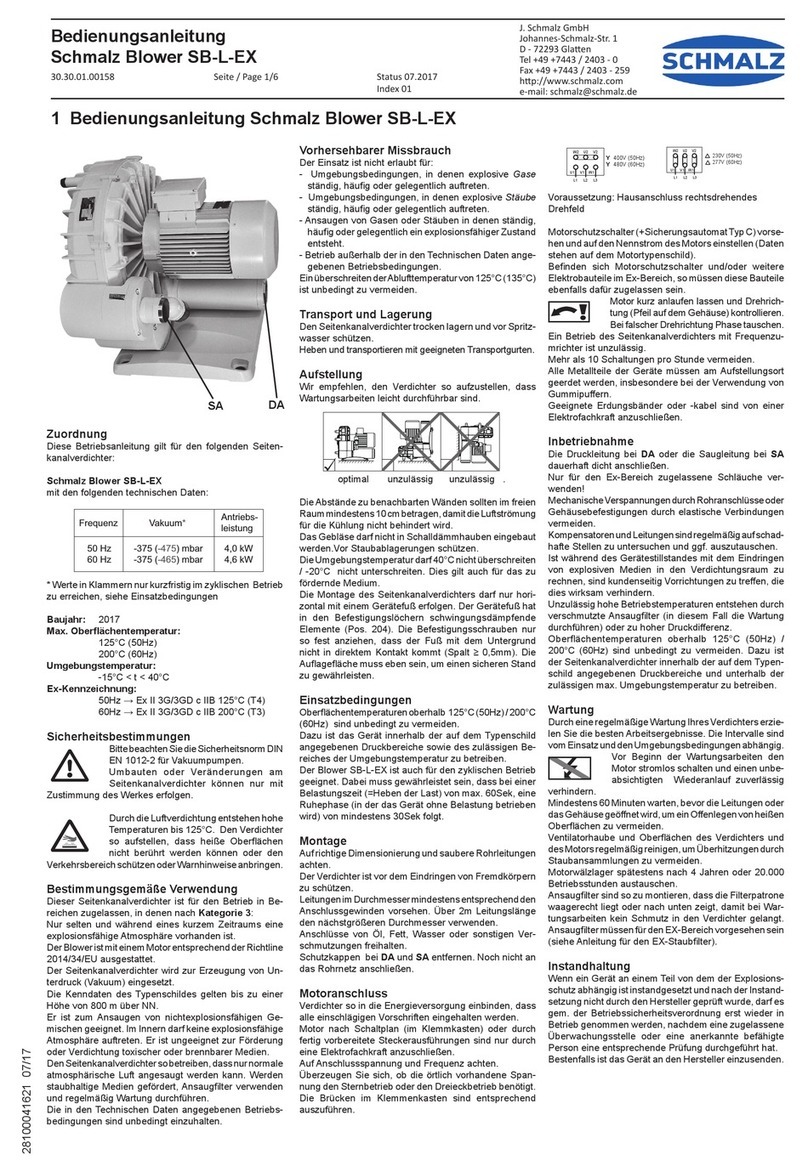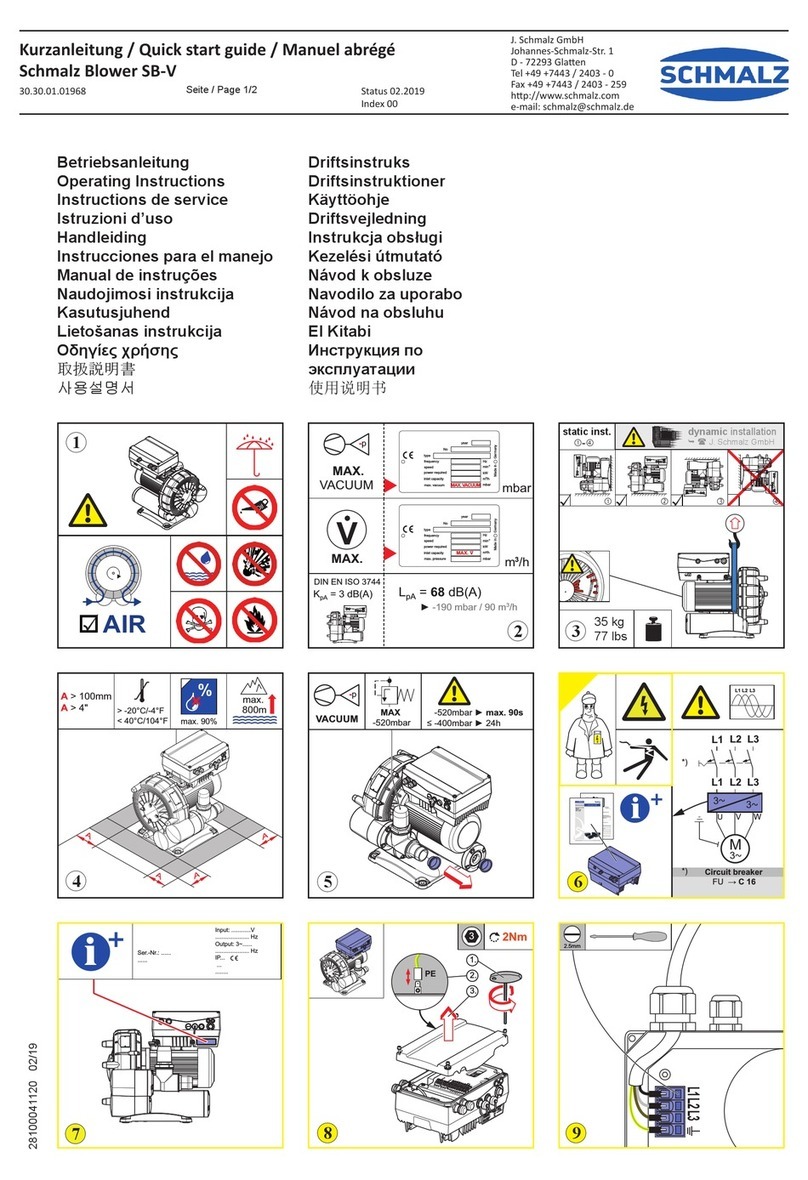
30.30.01.03275 Status 11.2022
Index 02
J. Schmalz GmbH
Johannes-Schmalz-Str. 1
72293 Glaen, Germany
Tel. +49 +7443- 2403- 0
Fax +49 +7443 / 2403 - 259
hp://www.schmalz.com
Instruction Manual
Schmalz Blower SB-L-EX
Page 1/2
1 Instruction Manual Schmalz Blower SB-L-EX
Scope
These operating instructions apply to the following
side-channel compressors:
Schmalz Blower SB-L-EX
with the following technical data:
* Values in brackets can only be achieved for a short time
in cyclic operation, see conditions of use
Year of manufacture: 2022
Max. surface temperature:
190 °C (50 Hz)
190 °C (60 Hz)
Ambient temperature:
-10 °C < t < 40 °C
Explosion protection labeling:
II 3G/3G Ex h IIB T3 Gc/Gc X
II -/3D Ex h IIIB 190°C -/Dc X
Safety regulations
Please observe the safety standard DIN
EN 1012-2 for vacuum pumps.
Modications or changes to the side-chan-
nel compressor can only be made with the
approval of the factory.
Air compression produces high tempera-
tures >60 °C. Position the compressor so
that hot surfaces are out of reach, cordon
o the trac area or provide warning signs.
Intended use
This side-channel compressor is authorized for use in
areas where explosive atmospheres are present only
rarely and for a short period of time (category 3).
The motor corresponds to Directive 2014/34/EU.
The side-channel compressor is used to generate a
vacuum.
The key data on the type plate applies up to an altitude
of 800 m above sea level. For installation outside of
this range, the manufacturer must be consulted and the
application must be examined on a case-by-case basis.
The device is suitable for sucking in mixtures which are
not liable to explode. It must be ensured that an explosive
atmosphere does not form inside the device for extended
periods of time. The device is not suitable for conveying or
compressing toxic or ammable media. Matter must never
be allowed to accumulate inside the device, as this could
result in a possible imbalance. Operate the side-channel
compressor in such a way that only normal atmospheric
air can be sucked in.
If media containing dust is conveyed, use suction lters
and carry out maintenance regularly. Pyrophoric dusts/
dusts with pyrophoric properties are never to be conveyed.
The operating conditions specied in the technical data
must be complied with at all times.
The ambient temperature must not exceed 40 °C and must
not fall below -10 °C. This also applies to the medium to
be conveyed.
Foreseeable misuse
Use is not permitted for:
- Ambient conditions in which explosive atmospheres of
gases, vapors or mist occur frequently or occasionally
(category 1 or 2).
- Ambient conditions in which explosive dusts occur con-
tinuously, frequently or occasionally (category 1 or 2).
- Suction of gases or dusts in which an explosive state is
continuously, frequently or occasionally formed.
- Operation outside the operating conditions specied in
the technical data.
Exceeding the exhaust air temperature of 190 °C must be
avoided. If necessary, this must be ensured by monitoring.
Transportation and storage
Store the side-channel compressor in a dry place and
protect from water splashes.
Lift and transport with suitable transport belts.
Setup
We recommend that you install the compressor in such
a way that maintenance work can be carried out easily.
optimal unacceptable unacceptable
There must be at least 10 cm of free space between the
device and adjacent walls, so that the air ow for cooling
is not obstructed.
The blower must not be installed in silencer box covers.
Protect against dust deposits.
The side-channel compressor may only be mounted
horizontally with a base. The base has vibration-reduc-
ing elements (item 511) in the mounting holes. When
tightening the fastening screws, ensure that the base
does not come into direct contact with the ground (gap
≥ 0.5 mm). The contact surface must be level to ensure
that the base stands securely. Direct exposure to the sun
should be avoided.
Operating conditions
Surface temperatures above 190 °C must be avoided.
The device must be operated within the pressure ranges
indicated on the type plate and within the permissible
ambient temperature range.
The Blower SB-L-EX is also suitable for cyclic operation.
It must be ensured that a load time (= lifting the load) of
max. 60 seconds is followed by a rest phase (in which the
device is operated without load) of at least 30 seconds.
Mounting
Ensure correct dimensioning and clean pipelines. Prevent
foreign objects from entering the compressor.
The diameter of the pipes must correspond to the con-
nection threads as a minimum requirement. Use the next
largest diameter for pipes longer than 2 m.
Keep connections free of oil, grease, water or other
contaminants.
Protective caps should only be removed shortly before
mounting for DA and SA devices. Do not connect to the
pipe network yet.
Install the suction lter with the lter cartridge in a hori-
zontal position or facing downward so that no dirt enters
the compressor during maintenance work. Suction lters
must be provided for the explosion protection area (see
instructions for the explosion protection dust lter).
Connecting the motor
Integrate the compressor into the power supply in such a
way that all relevant regulations are observed, in particular
DIN EN IEC 60079-14 and DIN EN IEC 60079-17.
The motor must only be connected by a qualied electrician
in accordance with the circuit diagram (in the terminal box)
or using ready-to-use connector models.
Pay attention to the supply voltage and frequency.
Check whether the local voltage requires a star or delta
connection. The bridges in the terminal box must be
implemented in accordance with the information sheet
displayed.
Prerequisite: house connection with clockwise rotary
eld
Provide a motor-protection switch (+ type C circuit-breaker)
and adjust to the rated current of the motor (data is shown
on the motor type plate).
If there are motor protection switches and/or other electrical
components in the hazardous area, these components
must also be approved for this purpose.
Let the motor start up briey and check
the direction of rotation (arrow on the
housing). Switch phases if the direction of
rotation is incorrect.
Operation of the side-channel compressor with frequency
inverters is prohibited.
Avoid more than 10 switching operations per hour.
All metal parts of the device must be grounded at the
installation site, especially when using rubber buers.
Appropriate grounding straps or cables must be connected
by a qualied electrician.
Start of operations
Ensure the connection of the pressure line for the DA or
the suction line for the SA is durable and secure.
Only use hoses approved for the explosion protection area.
Avoid mechanical stresses caused by pipe connections or
housing attachments using elastic connections.
Expansion joints and lines must be inspected regularly
for damaged areas and replaced if necessary.
If explosive media can be expected to penetrate the
compression chamber during the equipment shutdown,
devices must be provided by the customer to eectively
prevent this.
Inadmissibly high operating temperatures result from
dirty suction lters (in this case carry out maintenance)
or excessive pressure dierence.
Maintenance
Maintenance and servicing of the vacuum pump may
only be carried out by specially trained, instructed and
authorized personnel. Only original spare parts from the
manufacturer may be used. Regular maintenance of the
compressor will provide the best results. The intervals
depend on the application and the ambient conditions.
Prior to the start of the maintenance
work, switch the motor o and prevent
an unintentional restart.
Wait for at least 60 minutes before opening the lines or
housing to prevent hot surfaces from being exposed.
Clean the fan hood and the surfaces of the compressor
and motor regularly to prevent overheating due to dust
accumulations.
Replace the roller bearings in the motor at the latest after
4 years or 20,000 operating hours. Maintenance is carried
out on the bearings every 2 years. Shaft sealing rings
are replaced every 6000 hours and at the same time as
the bearing is changed. After changing, the shaft sealing
rings must be run in for 1 hour in a test run. No explosive
atmosphere may be present during the run-in phase.
If lters are used, the lter cartridges should be cleaned
depending on the amount of dust (daily to weekly).
Cleaning must not be carried out while the device is hot.
Let the device cool down. Blow through the lter from the
inside to the outside with compressed air. Wipe or suction
the inside of the lter housing. Always replace damaged,
blocked, oily and greasy cartridges. The cartridges should
be replaced on a monthly or annual basis.
Inlet and outlet lines on the suction and pressure side
must be checked for damage and leaks and replaced
if necessary.
Servicing
In accordance with the German Ordinance on Industrial
Safety and Health (2009/104/EC), If a device in a system
on which explosion protection is dependent is repaired and
has not been checked by the manufacturer after the repair,
it may only be put back into operation after an approved
/
8 9 :
/ /
: 8 9
<9+]
<9+]
/
8 9 :
/ /
: 8 9
9+]
9+]
Frequency
Type Vacuum*Drive
power
50 Hz
60 Hz
50 Hz
5,5 kW
5,5 kW
4,6 kW
1
2
4
-360 (-475) mbar
-340 (-465) mbar
-360 (-475) mbar
SA DA

























